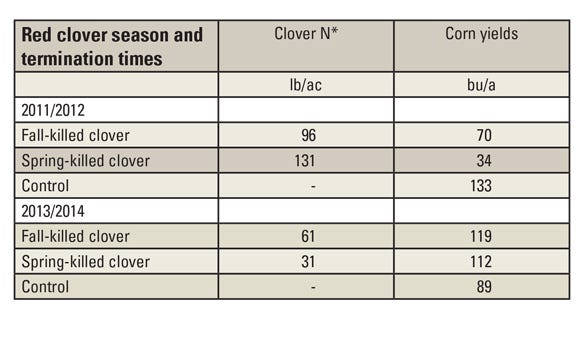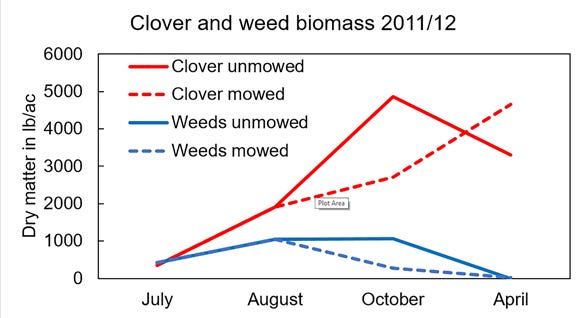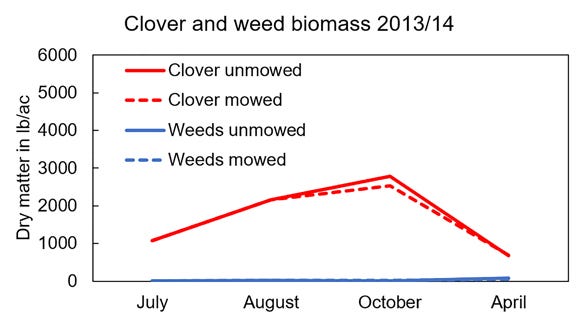April 1, 2020

Red clover can be an excellent green manure that fixes nitrogen, suppresses weeds and increases corn yields. As a slow-growing, cool-season legume, it is suitable to undersowing into winter small grains in early spring.
It continues to grow after small grain harvest and can be terminated in the fall or following spring before corn planting.
In 2011-12, 2012-13 and 2013-14, University of Nebraska-Lincoln researchers grew red clover in an organic soybean-winter wheat-corn rotation near Mead, Neb., with the goal of providing nitrogen to the following corn crop.
The results from the drought year 2012-13 are not included because red clover failed to grow. The research compared red clover to a control that did not receive N fertilizer, but was disked two to three times to keep it weed-free. Soils at this site are silty clay loam.
Winter wheat "Overland" was no-till drilled into soybean stubble in mid-October, and medium red clover "Marathon" was frost-seeded into standing winter wheat in mid- to late March with a Vicon broadcast spreader at a rate of 20 pounds per acre.
Frost-seeding is a method of broadcasting where seeds are spread onto frozen ground or snow in late winter or early spring and are worked into the ground through the freezing and thawing of the soil. Winter wheat was harvested in July. Half of the red clover plots were mowed once in early September, and the rest were not mowed.

Figure 1. Red clover biomass (dry matter) N content in pounds per acre and the yields of corn following red clover for the 2011-12 and 2013-14 seasons. Red clover was terminated by disking either in the fall (fall-killed) or spring (spring-killed). The control plots had no red clover and received no other fertilizer. *Biomass N content was calculated using biomass %N from the 2011-12 season and multiplying with the biomass dry matter values obtained in each season.

Red clover was terminated by disking in the fall (October) or spring (April). Corn was planted two weeks after clover spring disking. Corn did not receive any fertilizer and was organically managed.
The frost-seeded red clover had good emergence but little growth before wheat harvest. It did not affect wheat yield in any year (average wheat yield was 57.7 bushels per acre). Once wheat was harvested, red clover grew rapidly.
By August of both years, just before mowing, red clover had about 2,000 pounds per acre of biomass (see Figures 2 and 3). By the fall, it produced about 2,500 pounds per acre except for the unmowed red clover in 2011-12, which reached 4,900 pounds per acre biomass.
The higher productivity was probably because of the greater rainfall in July and August of 2011-12 than during the same period of 2013-14. Rainfall during the rest of the March-to-October red clover growing season was near normal in both years.
Spring biomass was high in the unseasonably warm spring of 2011-12, and much lower in 2013-14. Red clover biomass was 1.9% N in the fall and contained 61 to 96 N pounds per acre (Figure 1). In the spring, red clover biomass was 3.9% N and contained 31 to 131 N pounds per acre.
Researchers did not measure how much of red clover biomass N was taken up from the soil and how much was fixed, but other studies found that about 75% of N in undersown red clover was from N fixation.

Figure 2. Red clover and weed biomass (in pounds per acre of dry matter) during the 2011-12 season. Biomass was sampled at the time of wheat harvest (July), just before mowing (August), fall termination (October) and at spring termination (April).

Using these numbers, the research team estimates that in 2011-12 red clover fixed 72 pounds N per acre by the time of fall termination, and 98 pounds N per acre by the time of spring termination. In 2013-14, fall-terminated red clover fixed 46 pounds N per acre, and spring-terminated red clover fixed 23 pounds N per acre.
Control plots were disked for weed control, but there was no tillage in the clover plots. Mowing the red clover reduced weeds in 2011-12 (Figure 2), but weed pressure was generally greater in this year because of above-average July and August rainfall.
By the spring, no weeds were present in the red clover plots. In 2013-14, all red clover plots had less than 100 pounds per acre weed biomass in the fall and spring (Figure 3), indicating red clover's potential to suppress weeds.
Red clover effects on corn yields were variable. Corn yields were generally low because this was an organically managed trial that did not receive other fertilizer or recently applied manure. Red clover in 2011-12 contained much N, but that N was likely not used by corn.
During the drought year of 2012, corn grown after red clover likely suffered from a soil water deficit because of water use by red clover, which reduced corn yields compared to the control (Figure 1).

Figure 3. Red clover and weed biomass (in pounds per acre of dry matter) during the 2013-14 season. Biomass was sampled at the time of wheat harvest (July), just before mowing (August), fall termination (October) and at spring termination (April).

Corn yield was especially low after spring-terminated red clover, which probably left a greater soil water deficit. In 2014, a year with more "normal" rainfall, red clover increased corn yield compared to the control, likely because of the added N from red clover.
Undersowing red clover into winter wheat can help control weeds after winter wheat harvest and provide some N to next year's corn crop. In years with average precipitation, growers can expect red clover to contain about 80 pounds per acre of N, with the majority of N coming from fixation.
For high corn yields, clover should not be the only N source. Further, terminating red clover in the fall may allow for more time for decomposition, as well as soil water recharge.
For more information on undersowing red clover into winter small grains, contact Katja Koehler-Cole at [email protected].
Koehler-Cole is a research assistant professor in the Department of Agronomy and Horticulture; Brandle is an emeritus shelterbelt ecologist in the School of Natural Resources; Shapiro is an emeritus professor at the Department of Agronomy and Horticulture; and Francis is a professor of agronomy at the University of Nebraska-Lincoln.
Source: UNL CropWatch, which is solely responsible for the information provided and is wholly owned by the source. Informa Business Media and all its subsidiaries are not responsible for any of the content contained in this information asset.
You May Also Like




